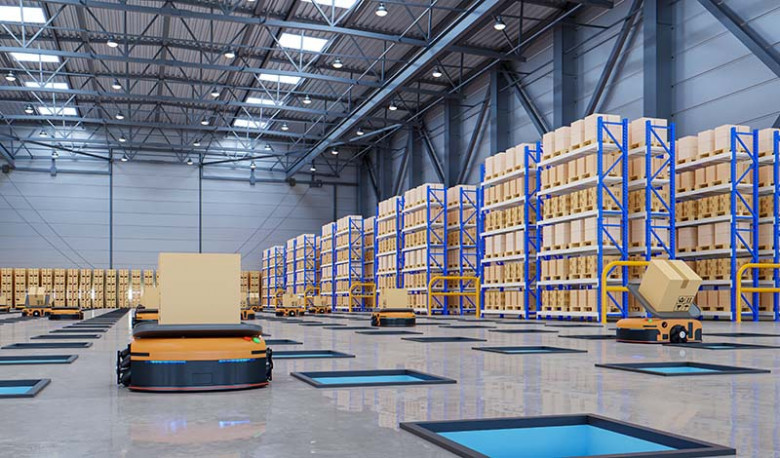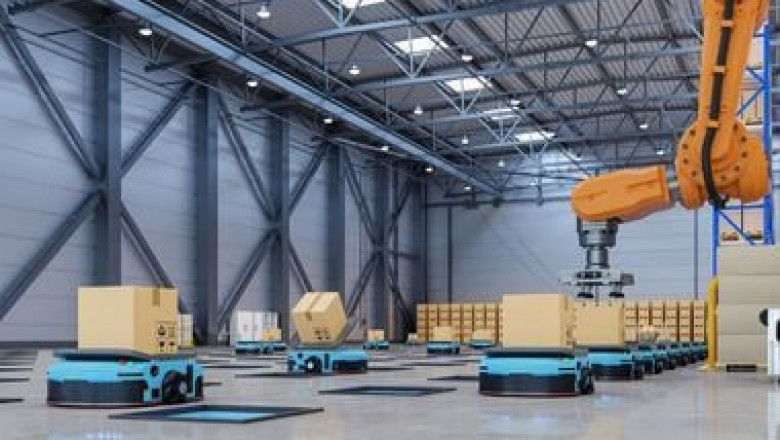views
How Omron, MIR, and Locus Robotics Are Leading the AMR Industry: Innovations and Success Factors

Introduction:
Autonomous Mobile Robots (AMR) have rapidly transformed industries by increasing efficiency, improving safety, and reducing labor costs. Among the market leaders in the AMR sector are Omron, Mobile Industrial Robots (MIR), and Locus Robotics, collectively commanding approximately 23% of the market share. These companies have driven significant advancements in the field, offering solutions that address the growing demands of logistics, manufacturing, and other industries requiring automation.
Download FREE Sample of Autonomous Mobile Robots Market
This article delves into the factors behind their success and focuses on the innovative technologies that have placed these companies at the forefront of the AMR industry, with a special emphasis on Omron's advanced sensor technology, the heart of their autonomous robots.
The Rise of AMRs in the Industry
Autonomous Mobile Robots are self-guided machines that perform tasks such as material transportation, warehouse management, and inventory tracking without human intervention. These robots utilize a combination of sensors, cameras, artificial intelligence (AI), and machine learning algorithms to navigate dynamic environments.
The AMR industry has experienced significant growth over the past decade, driven by advancements in sensor technology, increased demand for automation, and the need for more flexible and scalable solutions in industries like logistics, warehousing, and manufacturing. With the rise of e-commerce and the need for faster delivery times, companies have been looking for innovative ways to streamline their operations.
Omron, Mobile Industrial Robots, and Locus Robotics have each carved a niche in this evolving market by introducing solutions that cater to these demands. Their ability to scale up operations while maintaining high levels of precision and safety has made them highly sought after.
Omron’s Advanced Sensor Technology: The Heart of Their Autonomous Robots
Omron, a global leader in automation technology, has carved a strong position in the AMR industry with its innovative use of sensor technology. Sensors are crucial for the navigation, safety, and efficiency of autonomous robots, and Omron has developed cutting-edge sensors that enhance the capabilities of its robots in complex environments.
Omron’s Sensors for Accurate Navigation and Obstacle Detection
Omron’s robots are equipped with a variety of sensors that provide real-time feedback to enable precise navigation. These sensors include LiDAR (Light Detection and Ranging), ultrasonic sensors, and 3D vision systems, which help the robots to map their surroundings, detect obstacles, and adapt to changing conditions in real-time.
-
LiDAR: LiDAR sensors emit laser beams to map out the environment in three-dimensional space, enabling the robot to detect objects, calculate distances, and avoid collisions. Omron’s LiDAR technology allows robots to navigate with high precision, even in complex or cluttered environments.
-
Ultrasonic Sensors: These sensors are used to detect objects in close proximity and are especially effective for short-range detection. Omron’s ultrasonic sensors help improve the robot’s ability to maneuver around obstacles in tight spaces, increasing operational efficiency.
-
3D Vision Systems: Omron incorporates 3D vision systems into its robots to improve object detection and recognition. This advanced sensor system enables the robot to understand and interpret its environment with high accuracy, ensuring safe navigation and better decision-making capabilities.
These sensors work together to ensure that Omron's autonomous robots can safely navigate through dynamic environments, adapt to new conditions, and perform tasks with minimal human intervention. This reliance on sensor technology sets Omron apart from its competitors and has contributed to its growing presence in the AMR market.
Mobile Industrial Robots (MIR) and Their Focus on Flexibility and Safety
Mobile Industrial Robots, a subsidiary of Teradyne, is another key player in the AMR sector. MIR’s success lies in its ability to offer flexible and scalable solutions for a variety of industries, including logistics, manufacturing, and healthcare. One of MIR’s key strengths is the integration of advanced safety features and robust navigation systems, which make its robots versatile and reliable in dynamic environments.
MIR’s Commitment to Flexibility
MIR’s autonomous robots are designed to be highly adaptable to different environments, allowing businesses to easily integrate them into their existing workflows. MIR robots are used for material handling, inventory management, and even cleaning tasks. Their modular design means they can be customized to suit a wide range of operational needs.
MIR robots are equipped with a suite of sensors that enable them to navigate through tight spaces, avoid obstacles, and perform tasks in dynamic environments. MIR’s emphasis on safety is also evident in its robots’ ability to work alongside human employees without requiring significant changes to the work environment. This adaptability is one of the reasons MIR has gained a strong foothold in the AMR market.
Locus Robotics: Revolutionizing Warehouse Automation
Locus Robotics is another key player that has revolutionized warehouse automation with its autonomous robots. Focused on solving challenges within e-commerce, Locus Robotics has introduced autonomous robots designed to collaborate with human workers, increasing warehouse productivity and operational efficiency.
Collaborative Robots (Cobots) for Enhanced Efficiency
Locus Robotics’ robots are designed to work in tandem with human employees in a warehouse setting. These collaborative robots, also known as cobots, are able to carry out tasks such as picking, sorting, and transporting items to designated locations. By working alongside human workers, cobots allow for a more efficient and safer workflow, reducing the strain on employees and increasing overall productivity.
Locus Robotics’ success in the AMR market can be attributed to the robots’ ability to seamlessly integrate into existing warehouse operations. The company’s robots are highly flexible, enabling businesses to scale their operations without significant capital investment in new infrastructure. Locus’ cobots also leverage advanced navigation and sensor technologies to ensure safe and precise operation in dynamic environments.
The Role of Artificial Intelligence in AMRs
Artificial Intelligence (AI) plays a crucial role in the functioning of AMRs, enabling them to learn from their environment and improve their performance over time. AI algorithms help robots make decisions, navigate complex environments, and optimize tasks. In combination with advanced sensor technologies, AI enhances the robots’ ability to interact with their surroundings and perform tasks more efficiently.
Omron, MIR, and Locus Robotics have all integrated AI into their autonomous robots, allowing them to improve their performance through machine learning. This means that these robots can adapt to new environments, optimize their paths, and continuously improve their efficiency. The combination of AI and sensor technologies makes these robots highly effective in real-world applications.
How Omron, MIR, and Locus Robotics Handle Dynamic Environments in Real-Time
Handling dynamic environments in real-time is one of the key challenges faced by autonomous robots. Real-world environments are often unpredictable, with obstacles appearing suddenly, changes in layout, and human interaction that require robots to adjust their behavior on the fly. To address this challenge, Omron, MIR, and Locus Robotics have developed advanced systems that enable their robots to adapt in real-time.
-
Omron: Through the integration of its advanced sensor technologies, Omron’s robots can react quickly to changes in their environment. LiDAR and 3D vision systems enable Omron robots to detect obstacles and plan their movements accordingly, while AI algorithms help optimize their behavior based on the environment they are navigating.
-
MIR: Mobile Industrial Robots incorporate a flexible navigation system that allows their robots to adjust to sudden changes in their environment. MIR robots use a combination of sensors and AI to analyze their surroundings, ensuring they can safely navigate obstacles and work alongside human workers without interference.
-
Locus Robotics: Locus robots utilize AI and a combination of sensors to navigate dynamic warehouse environments. Their collaborative nature allows them to adapt to changes in the workflow and work seamlessly with human workers, adjusting in real-time to maximize efficiency.
The Future of AMRs: Continuous Innovation and Expansion
As the demand for automation continues to rise, the AMR market is expected to grow even further. Companies like Omron, Mobile Industrial Robots, and Locus Robotics will continue to drive innovation in the industry by improving their sensor technologies, enhancing AI capabilities, and expanding the applications of AMRs.
The integration of more advanced AI algorithms, the use of 5G networks for faster data transmission, and the development of new sensor technologies will all contribute to the future success of AMRs. As robots become more intelligent and capable of handling complex tasks, their adoption across industries will continue to rise.
Conclusion
Omron, Mobile Industrial Robots, and Locus Robotics have successfully positioned themselves as leaders in the AMR market by focusing on technological innovation, safety, and scalability. Omron’s advanced sensor technologies play a key role in the precision and efficiency of their robots, while MIR and Locus Robotics have excelled at creating adaptable, collaborative solutions for diverse industries.
With the growing adoption of AI and sensor technologies, the AMR industry is poised for continued expansion, and these companies are well-positioned to lead the charge. Their ability to handle dynamic environments in real-time, optimize operations, and improve safety makes them the go-to choice for businesses looking to leverage the power of automation in their operations. As the industry evolves, Omron, MIR, and Locus Robotics will continue to shape the future of autonomous mobile robots.






















Comments
0 comment